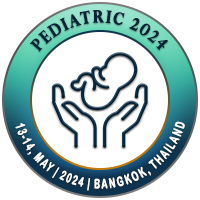
Analyn P Dizon
University of Manila, PhilippinesTitle: Prevalence of pediatric pleural effusion in a tertiary government hospital in Manila; A 3-year retrospective study
Abstract
Pleural effusion remains a diagnostic and therapeutic concern in pediatric patients, with sparse data from Manila's tertiary hospitals.
Objective: The purpose of this study is to determine the prevalence of pediatric pleural effusion in a tertiary government hospital in Manila from 2020-2023.
Methodology: This is a Retrospective descriptive study conducted in a tertiary government hospital in Manila, Philippines. Records from June 2020-June 2023 of pediatric patients diagnosed with pleural effusion were assessed. Extracted data covered demographics, clinical symptoms, causes, treatment approaches, and outcomes.
Results: The prevalence rate of pleural effusion is 0.8% based on overall number of admissions for the past three years. Most are males (63%), with 33% aged 0-5 years. Most (50.7%) stayed under two weeks. The primary symptom was a cough (23.8%), with pneumonia as the main cause (34.3%). Chest X-rays detected effusions in 67 patients, and 80% of ultrasounds confirmed this. Most effusions (80%) were exudative. Key microbes included a methicillin-resistant Staphylococcus aureus strain and others. Mortality was 22.3%, but 77.61% improved, with an average stay of 20.20 days.
Conclusion: Pleural effusion in children, thought of low prevalence, presents multifaceted challenges in Manila. This study highlighted the utility and limits of chest radiographs and showed ultrasounds as promising tools for effusion evaluation. Manila's government hospitals, facing resource constraints and prevalent infectious diseases, must navigate pleural effusion intricacies, underscored by the microbial data and resistance patterns found in this study. Pleural effusion's varied mortality rates based on underlying conditions emphasize the need for vigilant, comprehensive care.
Biography
Will be updated soon.

